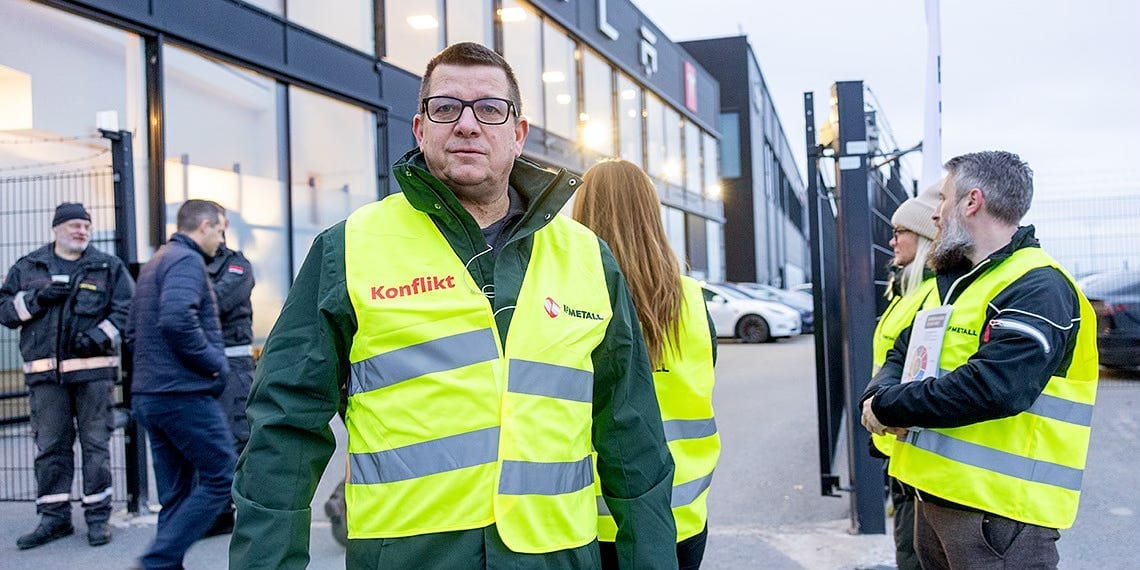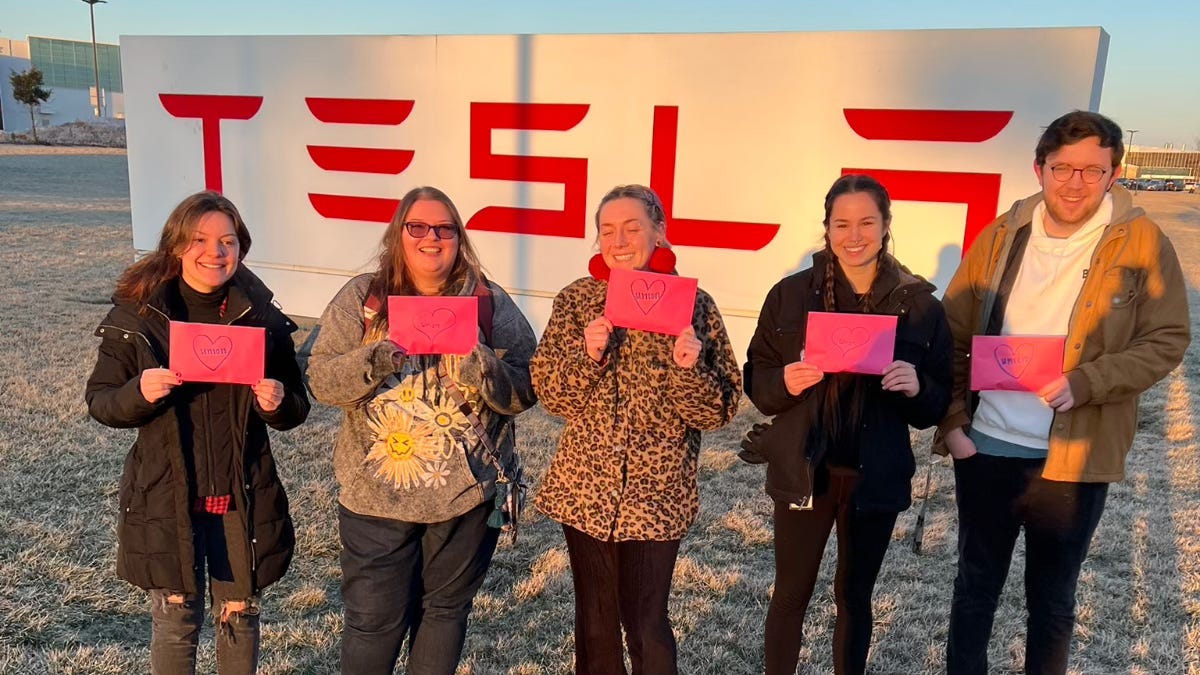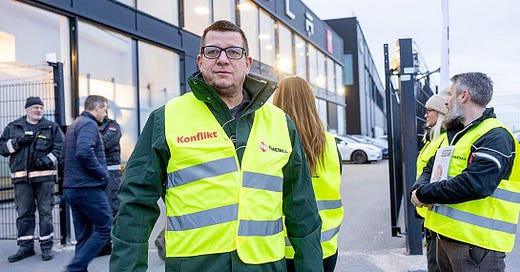
On October 27, 120 mechanics and service technicians at Tesla dealerships walked off the job. Starting November 3, another 470 workers at non-Tesla repair shops will begin supporting them by refusing to do any work on the company’s vehicles. The goal of these strikes is to pressure Tesla to negotiate a collective agreement. The reason you may not have heard of it is that it’s all happening in Sweden.
The Swedish labor model is built on collective agreements — about 90% of workers are covered by them — but Tesla is refusing to play ball, saying its company policy is not to negotiate in any country where it operates. IF Metall, the union that represents the workers, has been trying to get Tesla to come to the negotiating table since 2018. But the pressure on Tesla’s stance is about to rise significantly.
In Sweden, unions are allowed to engage in solidarity strikes. The Swedish Transport Workers’ Union is already threatening to extend the pressure to Sweden’s ports by refusing to allow any new Tesla vehicles into the country. The union movement seems ready for the fight, with IndustriALL general secretary Atle Høie saying, “Elon Musk’s business model is to avoid respecting human rights. Now he is taken on by one of our strongest unions. We must defeat the Tesla business model, and Sweden is the best place to start.”
Sweden may be where it starts, but it’s certainly not where it ends. Christiane Benner, the new head of IG Metall in Germany, has Tesla’s Berlin factory in her crosshairs, warning the company about attempts to union bust. But the pressure isn’t just growing in Europe; unions in North America seem ready for a renewed push too.
The UAW has momentum
In recent weeks, the United Auto Workers (UAW) has won a series of historic contracts with Ford, General Motors, and Stellantis — the Big Three North American automakers. The union won significant pay rises for employees, got Stellantis to reopen an idled plant that employed 1,200 people, and negotiated for the right to strike over plant closures and product and investment decisions. But on top of that, it also succeeded in getting many of the Big Three’s electric vehicle and battery facilities under the union’s master agreement or eased the path to unionizing them.
The transition to electric vehicles has been a major concern for auto workers and their unions, as they could see auto companies using it to try to shift to non-union labor. The UAW’s contract wins ensure that will be much harder to do at the Big Three, and now it’s broadening its horizons to the wider industry.
UAW President Shawn Fain took office in March, just months ahead of the end of the Big Three contracts, and he took a much more militant approach than the old leadership that’s proven to have massively paid off for the workers. But those new contracts will run until 2028 — longer than usual — and when asked why, Fain was very clear: “One of our biggest goals coming out of this contract victory is to organize like we’ve never organized before. When we return to the bargaining table in 2028, it won’t just be the Big Three, but with the Big Five or Big Six.”
And Tesla may be among them.
Not the first Tesla union drive

Tesla is the only major US automaker whose workers aren’t unionized. In 2016, a group of workers at its Fremont, California plant started working with the UAW on a union drive. They went public with their campaign in 2017, citing high injury rates, excessive mandatory overtime, constant understaffing, and pay that was below the industry average as the key reasons for needing a union. “Just as CEO Elon Musk is a respected champion for green energy and innovation, I hope he can also become a champion for his employees,” wrote Tesla employee Jose Moran. But Musk was not ready to play ball.
Tesla launched an anti-union campaign and Musk was open about his disdain for unions. He promised workers frozen yogurt stands and a “Tesla electric pod car roller coaster (with an optional loop the loop route, of course!)” if they didn’t unionize. He also said the claims about Tesla’s injury rate were “untrue” and they were actually less than half the industry average. Later reporting by Reveal found Musk’s claim wasn’t accurate and that Tesla wasn’t reporting all of its serious injuries.
Instead of showing concern for the workers’ concerns, Musk dismissed them and acted as though he was being targeted by major competitors. The UAW’s “true allegiance is to the giant car companies,” he alleged, “where the money they take from employees in dues is vastly more than they could ever make from Tesla.”
The National Labor Relations Board later found that Tesla violated US labor law in twelve different ways by trying to stop employees from unionizing, including everything from harassing organizers, firing people involved in the union, and trying to move them into new roles where they couldn’t organize. One of Musk’s tweets threatening the removal of workers’ stock options was also found to be illegal.
Pressure on Tesla is rising

As the aura around Musk has diminished over the past year, it’s reasonable to think that fewer of his employees are willing to toil in his hostile work environments and accept lower compensation all to realize his personal mission. Earlier this year, Tesla workers in Buffalo, New York who label Autopilot data announced a union drive under the name Tesla Workers United, only for dozens of employees to be fired on the spot to stop it — another illegal action by the company. But it won’t stop there.
Tesla workers can see the disparity between how they’re treated and what the CEO gets away with. Elon Musk got a $56 billion stock-based pay package from the company in recent years, premised on his ability to use deceptive promises to boost its share price. Meanwhile, analysts estimate Tesla workers earn about $45 an hour in wages and benefits, compared to $66 an hour at the Big Three before the new contract and up to $89 an hour going forward. Add to that the safety issues and the overwork that can come with Musk’s management style, and there are clear reasons to want collective power.
Tesla has ample resources to fight any union drive it faces, but Musk’s declining popularity could be a significant hinderance as fewer employees will be swayed by his personal intervention. In fact, they could be pushed even closer to the union. The UAW already has an organizing committee at the Fremont factory and has pledged to give it the resources it needs for its campaign. The union also has proof of what it can deliver for Tesla workers after winning major new contracts with the Big Three.
Fain’s personal involvement could be another benefit for the union, as he’s not scared to call out the billionaires at the top of the auto companies. “We can beat anybody,” he said when asked by Bloomberg about a potential Tesla campaign. “It’s gonna come down to the people that work for him deciding if they want their fair share... or if they want him to fly himself to outer space at their expense.”
Unionizing Tesla will be a challenge, there’s no question about it. But if there was ever a moment to try, this is it. The UAW has momentum, Tesla is struggling, and Musk isn’t the popular leader he was just a few years ago. A union would be good for Tesla workers, but there’s another added benefit that’s hard not to ignore: it would infuriate Elon Musk.
Tesla union now! ✊




